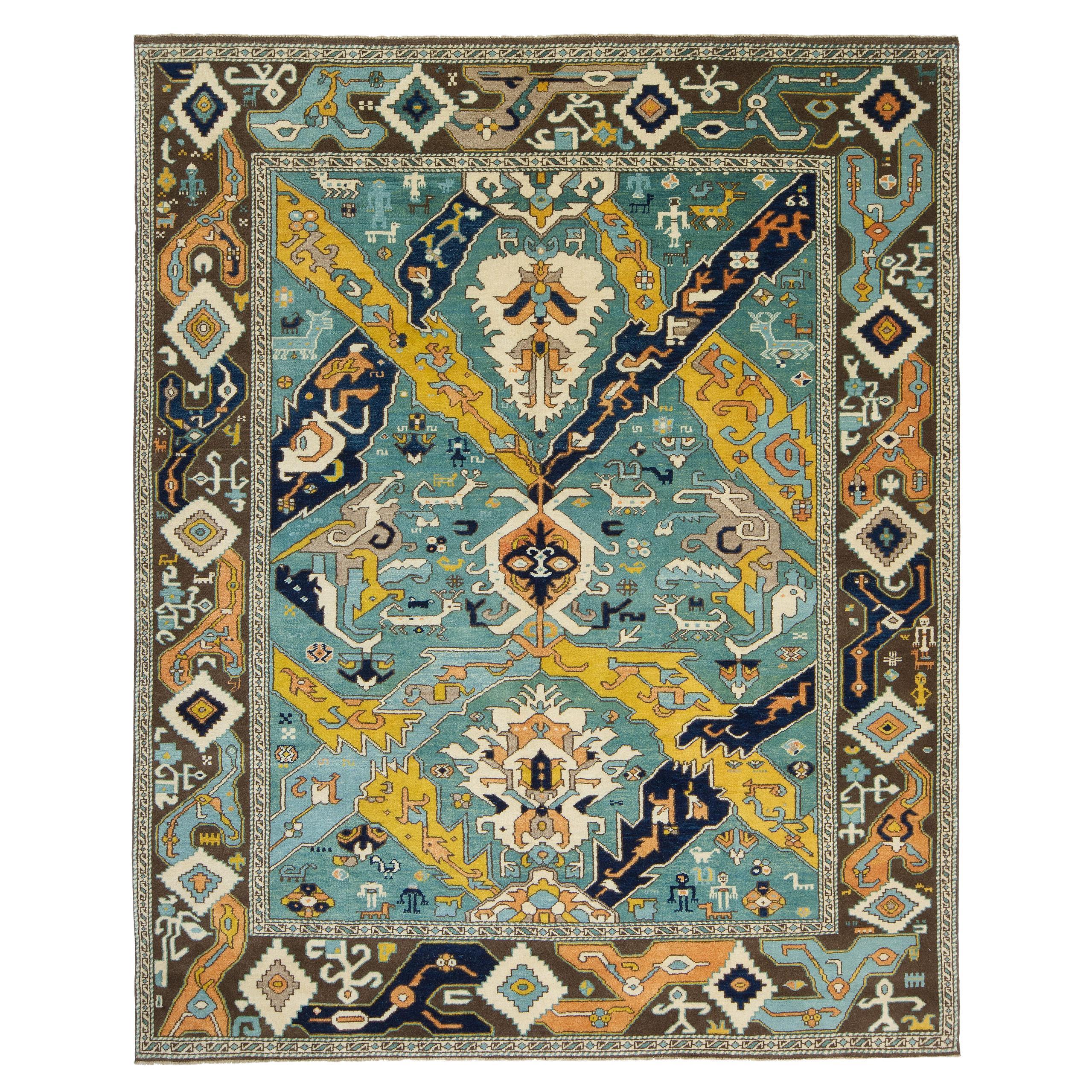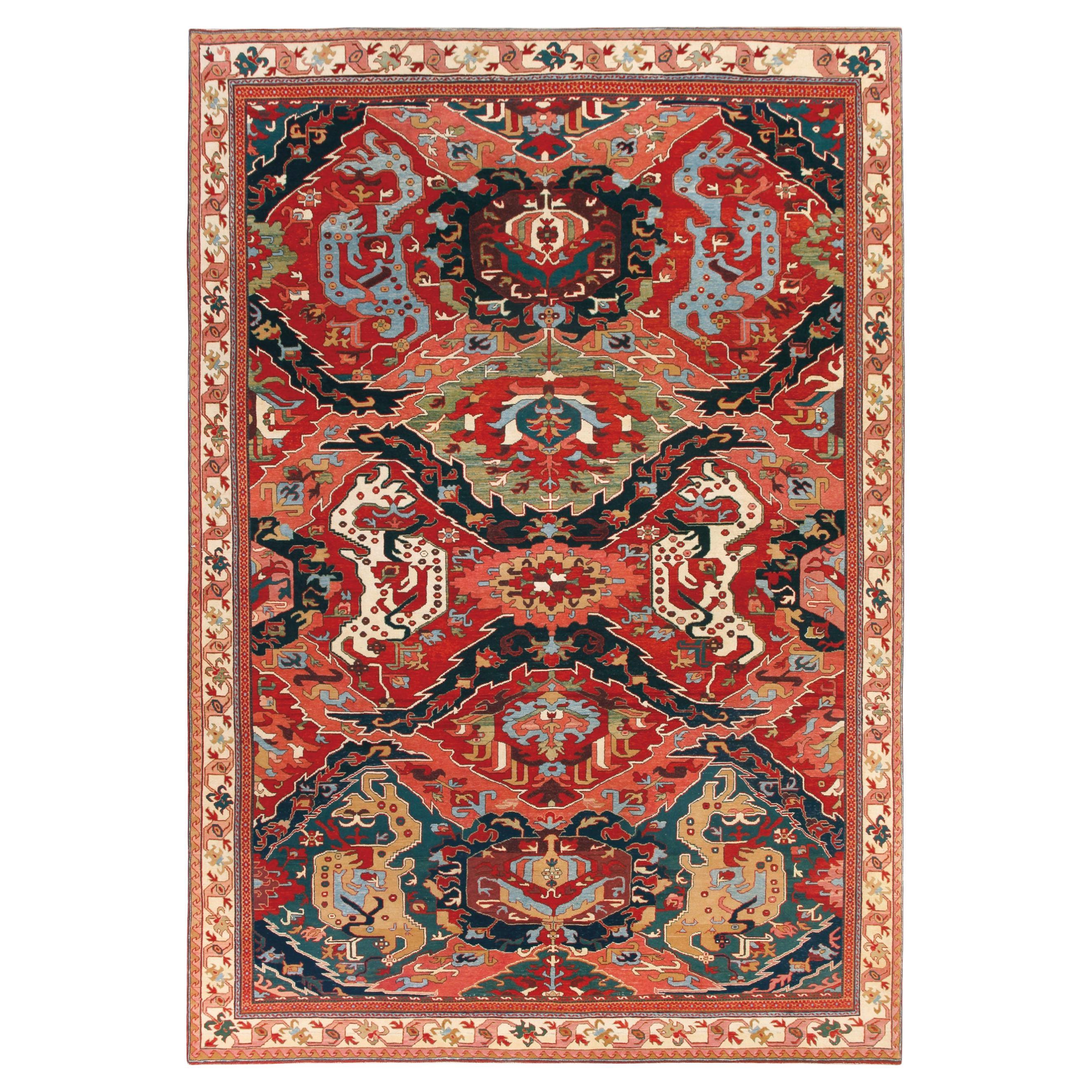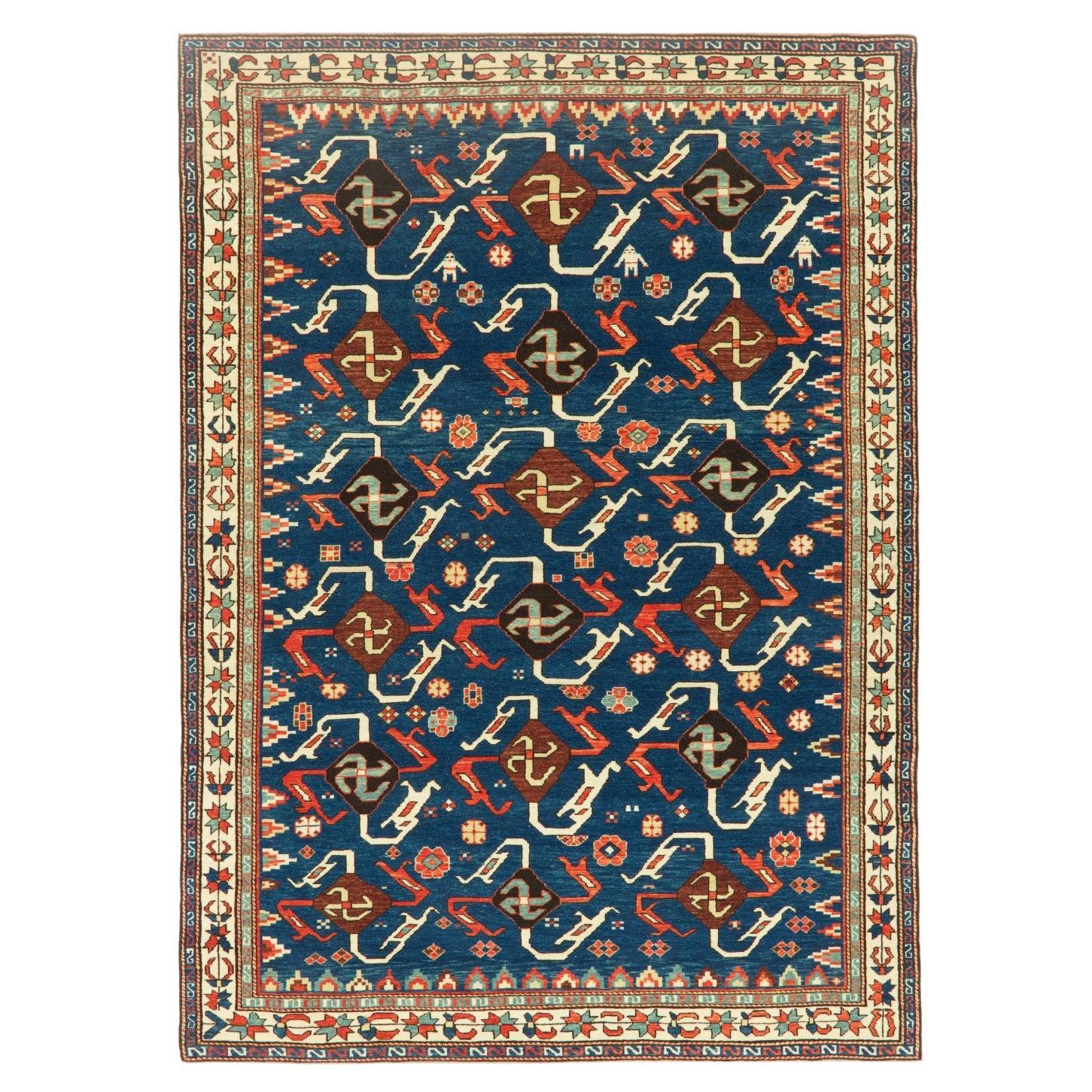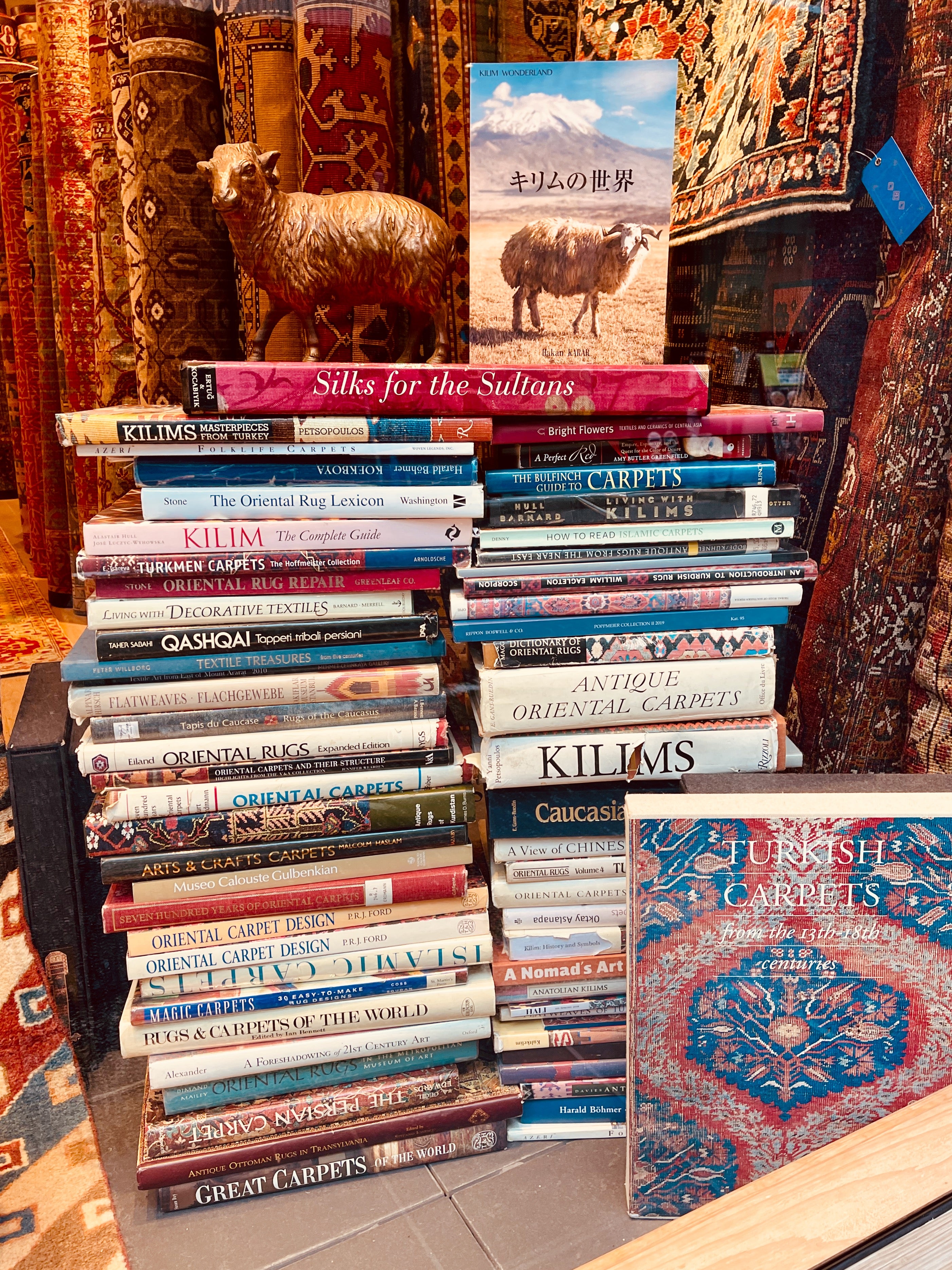Items Similar to Ararat Rugs Nigde Carpet, Antique Caucasus Museum Revival Rug, Natural Dyed
Want more images or videos?
Request additional images or videos from the seller
1 of 10
Ararat Rugs Nigde Carpet, Antique Caucasus Museum Revival Rug, Natural Dyed
About the Item
The source of the carpet comes from the book Islamic Carpets, Joseph V. McMullan, Near Eastern Art Research Center Inc., New York 1965 nr.41. This rug has become famous as the “Nigde Carpet.” Although certainly produced in the Caucasus, it was found in the mosque of Nigde in Central Anatolia and was published in 1908 by F. R. Martin shortly after its discovery.
In contrast to the other important rug types that have been produced in the same area, the Dragon Rugs and the so-called Kubas, the design of this carpet is highly unusual. It is based on a continuously alternating system of diamond-shaped medallions on a huge scale. One row of these diamond panels is filled with lancette leaves, palmettes, and cloud bands; the alternate row with large cruciform figures is filled with palmettes and surrounded by half-palmette and lancette leaves. Large palmette blossoms appear at the tips of the diamond points and in the center of each side of these panels. Alternating in the background color, the diamond panels create an almost unparalleled sumptuous effect. The border design follows a common Caucasian motif consisting of an alternate row of hexagonal cartouches, filled with stylized floral forms, and small floral rosettes. The other long-size example is exhibited at The Metropolitan Museum of Art (MET Museum Acc. No. 56.217). The design of this rug is interpreted and the most appropriate colors to match the original is used for this rug.
Color summary: 5 colors in total;
Yellow green 419 (Henna – Indigo)
Imperial red 426 (Madder Root)
Dark Sienna 431 (Madder Root)
Cadet blue 26 (Spurge – Indigo)
Sunray color 405 (Henna)
Group: Caucasian Rugs Family
Area: Kuba
Material of pile: natural dyed hand-spun wool
Material warp / weft: wool on wool
Structure: Symmetrical knot on depressed warp inclining to the right
Knots density: 39x39
Production Place: Southeastern Anatolia – Adiyaman Province - Bozatli
Stock Location: Tokyo
Size (EU): 255 X 370cm
Size (US): 8'4" X 12'1"
Area (EU): 9.4m²
Area (US): 101.6ft²
- Creator:Ararat Rugs (Manufacturer)
- Dimensions:Width: 100.4 in (255 cm)Length: 145.67 in (370 cm)
- Style:Revival (In the Style Of)
- Materials and Techniques:
- Place of Origin:
- Period:
- Date of Manufacture:2020
- Production Type:New & Custom(One of a Kind)
- Estimated Production Time:Available Now
- Condition:
- Seller Location:Tokyo, JP
- Reference Number:1stDibs: LU8206232755602
ARARAT RUGS
We know and believe that the geography we come from, our past, and our lifestyle are the most important bond between us to carry the oriental carpet art and culture to the next generations along with our core values in our ongoing growth journey.
We are aware that the way to achieve this goal and carry this priceless art and culture to the future depends on a lot of work with all our people every day while adhering to our core values.
For us, art is meaningful in the sense that it brings together various cultures around the world. It is an honor for us that oriental carpet art and culture have been instrumental in this for centuries and that we are a part of this business.
We are tirelessly keeping an eye on auction house information around the world about carpets. New York's Metropolitan, London's Victoria & Albert Museums, and other famous art museums, as well as small specialized museums that house private collections, and books about oriental carpets to collect information on outstanding carpet designs and patterns from around the world. It's our Self-improving and Self-developing culture.
As Turkish Culture of Hospitality, the Kurdish Culture of Generosity, and as Japanese Culture of Business Punctuality; are the most important values that this multicultural background has taught and bequeathed to us. It is essential and valuable for us that you feel this feeling not only by looking at our oriental carpets but from the moment you contact us.
About the Seller
5.0
Gold Seller
These expertly vetted sellers are highly rated and consistently exceed customer expectations.
Established in 1970
1stDibs seller since 2023
12 sales on 1stDibs
Typical response time: 1 hour
- ShippingRetrieving quote...Ships From: Tokyo, Japan
- Return PolicyA return for this item may be initiated within 7 days of delivery.
More From This SellerView All
- Ararat Rugs Dragon Rug, Antique Caucasus Museum Revival Carpet, Natural DyedBy Ararat RugsLocated in Tokyo, JPThe source of the rug comes from the book Caucasian Carpets, E. Gans-Reudin, Thames and Hudson, Switzerland 1986, pg.37. This luxurious and varied work is known as the Cassirer drago...Category
21st Century and Contemporary Turkish Revival Caucasian Rugs
MaterialsWool, Natural Fiber, Organic Material
- Ararat Rugs Dragon Rug, Antique Caucasus Museum Revival Carpet, Natural DyedBy Ararat RugsLocated in Tokyo, JPThe source of the carpet comes from the book Hali Magazine 1993 Issue 67, pg.93 and Hali Magazine 1992 Issue 61, pg.61. Peter Bausback, Mannheim, described it on the occasion of his ...Category
21st Century and Contemporary Turkish Revival Caucasian Rugs
MaterialsWool, Natural Fiber, Organic Material
- Ararat Rugs Dragon Rug, Antique Caucasus Museum Revival Carpet, Natural DyedBy Ararat RugsLocated in Tokyo, JPThe source of the rug comes from the book Caucasian Carpets, E. Gans-Reudin, Thames and Hudson, Switzerland 1986, pg.37. This luxurious and varied work is known as the Cassirer drago...Category
21st Century and Contemporary Turkish Revival Caucasian Rugs
MaterialsWool, Natural Fiber, Organic Material
- Ararat Rugs Dragon Rug, Antique Caucasus Museum Revival Carpet, Natural DyedBy Ararat RugsLocated in Tokyo, JPThere has long been a fascination with the symbolism of the dragon and its depiction in carpet weavings. The design of ‘Dragon’ carpets consists of a field pattern composed of different colored overlaid lattices formed of pointed, serrated leaves creating intersecting lozenges, which alternately contain palmettes and are flanked by confronting stylized dragons, birds, or animal figures. The most archaic of the ‘Dragon’ carpets include dragon motifs with birds and running animals relatively naturalistically drawn, which stand either alone or in confronting pairs facing a tree. The Graf carpet, originally found in a Damascene mosque, now in the Islamiches Museum, Berlin, is considered to be the oldest example of this type, see Serare Yetkin, Early Caucasian Carpets in Turkey, Vol. II, London, 1978, p.8, fig.118. Yetkin defines four types of ‘Dragon’ carpet: ‘Archaic’, ‘Four-Dragon’, ‘Dragon-and-Phoenix’ and as a further combined development of the latter, the ‘Two-Dragon’ style, of which the present carpet falls into the ‘Dragon-and-Phoenix group along with other examples, some of which include two fragments, one in the Museum fur Kunst und Gerwerbe, Hamburg; another in the Christian Museum, Esztergom, Hungary, a complete carpet in the Kier collection; an incomplete example in the Textile Museum, Washington, D.C; the ‘Cassirer’ Dragon carpet in the Thyssen-Bornemisza collection, Lugano; the Ali Pasa Mosque carpet in Tokat, and a further example in the Vakiflar Hali Museum, Istanbul (S. Yetkin, op. cit. pp.16-20). It has been suggested that the earliest examples of the Caucasian ‘Dragon’ carpets...Category
21st Century and Contemporary Caucasian Revival Caucasian Rugs
MaterialsWool, Natural Fiber, Organic Material
- Ararat Rugs Dragon Rug, Antique Caucasus Museum Revival Carpet, Natural DyedBy Ararat RugsLocated in Tokyo, JPThe source of the rug comes from the book Orient Star – A Carpet Collection, E. Heinrich Kirchheim, Hali Publications Ltd, 1993 nr.57. There has long been a fascination with the symbolism of the dragon and its depiction in carpet weavings. The design of ‘Dragon’ carpets consists of a field pattern composed of different colored overlaid lattices formed of pointed, serrated leaves creating intersecting lozenges, which alternately contain palmettes and are flanked by confronting stylized dragons, birds, or animal figures. The most archaic of the ‘Dragon’ carpets include dragon motifs with birds and running animals relatively naturalistically drawn, which stand either alone or in confronting pairs facing a tree. The Graf carpet, originally found in a Damascene mosque, now in the Islamiches Museum, Berlin, is considered to be the oldest example of this type, see Serare Yetkin, Early Caucasian Carpets in Turkey, Vol. II, London, 1978, p.8, fig.118. Yetkin defines four types of ‘Dragon’ carpet: ‘Archaic’, ‘Four-Dragon’, ‘Dragon-and-Phoenix’ and as a further combined development of the latter, the ‘Two-Dragon’ style, of which the present carpet falls into the ‘Dragon-and-Phoenix group along with other examples, some of which include two fragments, one in the Museum fur Kunst und Gerwerbe, Hamburg; another in the Christian Museum, Esztergom, Hungary, a complete carpet in the Kier collection; an incomplete example in the Textile Museum, Washington, D.C; the ‘Cassirer’ Dragon carpet in the Thyssen-Bornemisza collection, Lugano; the Ali Pasa Mosque carpet in Tokat, and a further example in the Vakiflar Hali Museum, Istanbul (S. Yetkin, op. cit. pp.16-20). It has been suggested that the earliest examples of the Caucasian ‘Dragon’ carpets...Category
21st Century and Contemporary Turkish Revival Caucasian Rugs
MaterialsWool, Natural Fiber, Organic Material
- Ararat Rugs Swastika Design Rug, Antique Caucasus Revival Carpet, Natural DyedBy Ararat RugsLocated in Tokyo, JPThe source of rug comes from the book Orient Star - A Carpet Collection, E. Heinrich Kirchheim, Hali Publications Ltd, 1993 nr.17. This is a remarkable and very unusual swastika designed early 19th-century rug from the Central Caucasia area. This unusual pattern is not known on other rugs but is seen on two Anatolian embroideries...Category
21st Century and Contemporary Turkish Revival Caucasian Rugs
MaterialsWool, Organic Material, Natural Fiber
You May Also Like
- Antique Caucasian Rug - Rare Caucasian Carpet, Caucasus Rug, Antique RugLocated in Sultanahmet, 34Rare Caucasian Rug Caucasus Rug Size: 176×224 cm This wonderful rug is a formerly unpublished addition to a small and rare group of blue-ground Caucasian rugs whose design is dominated by a prominent decahedral gabled ivory medallion. The overall pattern echoes that of a group of earlier 17th and 18th century north west Persian carpets, whose designs were based upon the Persian garden plan known as the “Four Gardens” or Chahar Bagh (M.S.Dimand & J. Mailey, Oriental Rugs in the Metropolitan Museum of Art, New York, 1973, p.84, fig.116). The smaller lozenges that extend above and below the central medallion on the present lot, are linked by a narrow vertical channel which represents the streams and ornamental pools that feed the flowering trees and shrubs on either side. The once eight-pointed medallion, that is an archaic form found in early Anatolian and Caucasian rugs, and which continues to be used throughout the nineteenth century in Fachralo rugs...Category
Antique 19th Century Caucasian Caucasian Rugs
MaterialsWool
- Antique Caucasus RugLocated in New York, NYAntique Caucasus rug, measures: 4'0" x 5'0".Category
Antique 1890s Caucasian Caucasian Rugs
MaterialsWool
- Antique Saddle- Carpet from CaucasusLocated in Alessandria, PiemonteSmall saddle in wool woven on a loom like a carpet; in the center at the bottom the cut for the saddle tree. It can be used with a saddle leather , or hung on the wall like a painti...Category
Early 20th Century Caucasian Other Central Asian Rugs
MaterialsWool
- Antique Rugs, Kazak Rug, Handmade Carpet Runner Oriental Rug from CaucasusLocated in Hampshire, GBAn antique rug rare Caucasian Kazak handmade carpet from the 18th century. This carpet is with an unusual geometric rug pattern on red brick background. This woven rug is surrounded ...Category
Antique Early 1800s Caucasian Kazak Caucasian Rugs
MaterialsOrganic Material, Wool, Cotton
- Antique Caucasus Veneh RugLocated in New York, NYAntique Caucasus Veneh rug. Size: 5'8" x 6'4".Category
Antique 1870s Azerbaijani Caucasian Rugs
MaterialsWool
- Antique Caucasus, Kazak RugLocated in New York, NYAntique Caucasus - Kazak rug, measures: 3'7" x 6'0".Category
Antique 1890s Caucasian Caucasian Rugs
MaterialsWool






